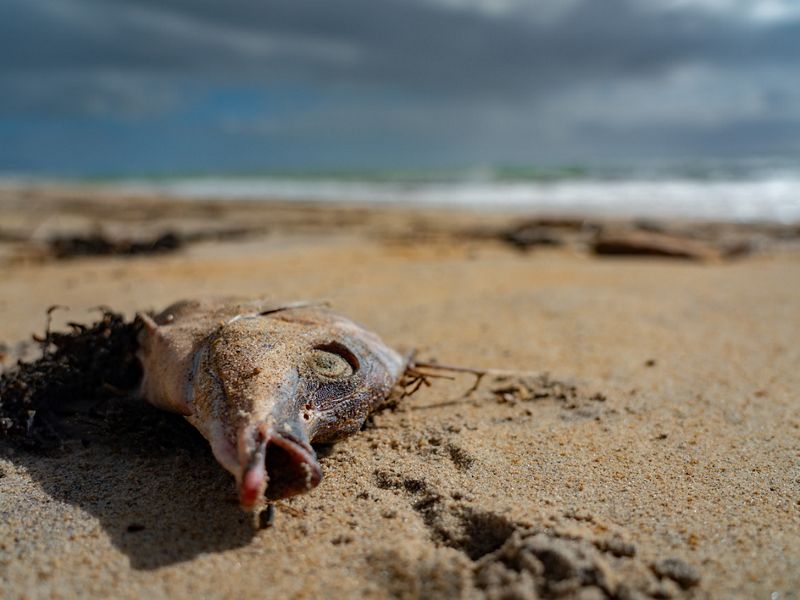
An Unprecedented Crisis South Australia's harmful Algal Bloom is killing millions of marine animals and disrupting the wellbeing and livelihoods of coastal communities. © Jarrod Boord / TNC Australia
An Urgent Threat
South Australia’s oceans face an unprecedented crisis. A harmful algal bloom is sweeping across coastlines, killing millions of marine animals, destroying habitats and disrupting the wellbeing and livelihoods of coastal communities. Threatened species such as the Leafy Seadragon and Giant Cuttlefish, found only in Australia, are at risk of extinction.
The impact extends far beyond the water. The bloom has hit South Australian businesses hard. Parts of South Australia’s seafood industry - worth an annual $478 million alone - have come to a standstill. That revenue, and those jobs, are now directly under threat.
Left unchecked, there is no end in sight. The bloom will continue to create larger ‘dead zones’, compromising the health of our oceans and the communities that depend on them.

A Natural Solution
It is not too late. There’s a way to turn the tide on this crisis and protect Australia’s oceans and coastlines from future marine disasters.
For millennia, vast shellfish reefs - beds of native oysters and mussels - filtered and cleaned Australia’s oceans, acting as the ‘kidneys of the sea’. But over the past century, 99% of these reefs have disappeared as a result of dredging and overharvest, leaving our seas and coastlines vulnerable.
A single oyster is capable of filtering a bathtub of water every two days, removing excess nutrients and eating up harmful algae. By restoring our lost shellfish reefs, we can give our oceans the kidney transplant they so desperately need, and safeguard businesses, jobs, communities, and our precious marine life.
A Proven Track Record
The Nature Conservancy has the science, the partnerships and the track record to rebuild these reefs at the scale required help our oceans recover and build resilience for the future. For more than 30 years we’ve led the way on shellfish reef restoration globally, and we’ve been working with our partners to bring them back across Australia since 2015.
We’re already leading the largest marine restoration initiative in Australia’s history - Reef Builder, having successfully restored shellfish reefs across more than 20 sites around the country. In South Australia alone, projects such as Windara Reef, Glenelg Reef, Nepean Bay and O’Sullivan Beach Reef are proving their resilience, removing algae and boosting fish populations.
The Price of Protection
This isn’t just about repairing the environment - it’s about building critical infrastructure for the future. To tackle this bloom and protect a national ocean economy worth $120 billion a year, we must invest in nature at the scale of the loss.
The South Australian and Federal Governments recently announced the Algal Bloom Summer Plan - a comprehensive joint initiative addressing the social, economic and environmental fallout of the bloom. Within the plan, $20.6 million has been committed to nature-based solutions, with around half of this to be invested in large-scale shellfish reef restoration. This investment is a vital and welcome first step toward rebuilding the natural filtration systems essential for mitigating future disasters. However, building reef infrastructure at the scale needed will require far greater investment.
An investment of at least $500 million over the next decade in South Australia, would allow reefs to be restored across much of their historic range, reviving our natural filtration systems and allowing our oceans to recover.
The return on investment is clear: cleaner water, thriving ecosystems, a stronger economy and more resilient oceans and coastlines - and all for a fraction of what we spend on other infrastructure like roads, rail and tunnels.
How You Can Help Turn the Tide
Restoring lost shellfish reefs can protect our oceans from future marine disasters - but we must act now.
The Nature Conservancy is ready to lead the way, and has the science, experience and partnerships to deliver at scale. But building reef infrastructure at the scale needed will require far greater investment - from all levels of government, and just as importantly, from corporate and philanthropic partners.
By committing to large-scale reef restoration now we can help bring balance back, protect our industries and communities and build healthy, resilient oceans for generations to come.
Help Turn The Tide To Beat the Bloom
We need to act now! The Nature Conservancy is ready to lead the way, and has the science, experience and partnerships to deliver at scale, but we need your help.
Sign the petition
Your voice can make waves - help us protect Australia's oceans.
Share this page
Spread the word that there is a solution and we need help to make it happen.
Support the work
Donate or partner with The Nature Conservancy Australia to beat the bloom.
Now is the time to give our oceans the “kidney transplant” they urgently need - and leave a legacy of thriving marine life, strong fisheries and vibrant coastal communities.

